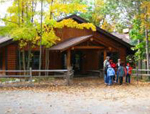There are so many retreats going on this time of year, that we at Acoustics By Design were forced to pick and choose which ones to attend. This year, it was the AIA Design Retreat at Torch Lake and the AIA Educational Facilities Planning Conference at Grand Traverse Bay Resort in northern Michigan. This post will highlight the Design Retreat. Think of it as an abbreviated “How I Spent My Summer Vacation” report, but with a lot less photographs and a lot more alcohol.
We arrived just before dusk at the Torch Lake YMCA Camp (Camp Waka-Haka-something-or-other) for the annual AIA Design Retreat. Yes, we stayed at a camp, in cabins, the whole nine yards. Heck, I didn’t even have a place to plug in my cell phone over night for a recharge. The two-day stint (September 12-13th) went by quickly as we observed 17 presentations of various architectural projects from the Michigan area. Here’s a glance at two of them…
Bryan Koehn, from Progressive AE, delivered a presentation on the West Michigan Center for Arts and Technology (WMCAT) in downtown Grand Rapids. I liked this project because I walk by the building several times a week (and never knew what it was all about until now) and because of the purpose behind the WMCAT. The facility is used to connect at-risk teens with mentors, by way of teaching the visual arts. These are teens who have been identified by local educators as being probable drop-out candidates, and the WMCAT is one of their last chances at success. But instead of a “skid row” on the road to high school delinquency, the program is presented as more of a “privilege” for the select few. The report is that they’re having tremendous success with students in the downtown area. Hats off to the Progressive AE team for creating a great environment for learning and mentoring.
Another great presentation was given by Jeff Hausman of SmithGroup. His project, “Indian Springs Metropark James Clarkson Environmental Discovery Center,” (quite a mouthful!) received the AIA Award for Sustainable Design. This facility was designed around the idea of teaching water conservation above the water, at the water, and under the water – which explains the building’s three levels. You can imagine how the first two levels worked – a 2 story building on the edge of a small pond, one story above the water, and one at water level. But the “under the water” level was the real fun part. To my surprise, they had actually built a cylindrical glass viewing room a couple feet under the surface of the pond itself, connected by a short tunnel to the basement of the main building. It was all the fun of scuba diving, but without the goggles. Of interest was how the water from the site was managed. All of the rainwater and drain water was reused, re-funneled, and re-channeled for the purpose of running the Discovery Center and sustaining the land itself. It was well designed and easy to manage. Congratulations to SmithGroup for designing this one-of-a-kind educational facility and teaching future generations about the importance of sustainable design.
The project presentations were well done (and a good way to grab up a bunch of CEUs.) For us at ABD, the overall camp experience was a good chance to network with industry professionals and to meet new friends. We let our hair down, stoked the campfire, and had a great AIA Design Retreat.
